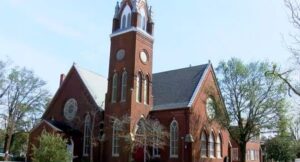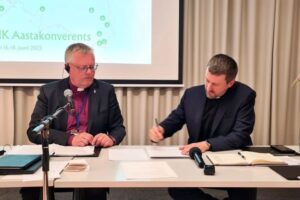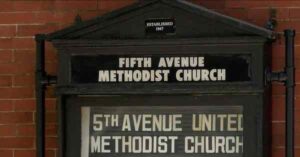The Best and Worst of Disaffiliation

By Thomas Lambrecht
As we reach the end of the regular annual conference season, the prospect of over 20 percent of United Methodist congregations disaffiliating from the denomination has aroused varying responses, from highly positive and gracious to extremely negative and punitive.
Most annual conferences experienced a relatively low-drama vote on congregations disaffiliating. As far as I know, no additional churches that voted to disaffiliate have been blocked. My own bishop in Wisconsin, Bishop Hee-Soo Jung, took care to create an atmosphere of grace and caring for one another that minimized conflict. The only difficulty came when lay members asked what could be done with the fact that they had not known about the option to disaffiliate until the deadline to start the process had passed. The answer was that, unfortunately, those churches would be unable to pursue disaffiliation at this time.
In other conferences, emotions were more raw. Several annual conferences made changes to their retirement health plans to prevent retired clergy who leave the denomination from participating in retiree health benefits. Some have wondered whether these benefits are earned benefits under federal law that cannot be taken away. In any event, it struck many as a punitive move that lacked grace. The Alabama-West Florida Conference tightened the qualifications for disaffiliation that some observers felt “put a nail in the coffin” for churches still wanting to disaffiliate. A newly-elected delegate to General Conference is quoted as saying in an email, “The days of mass and easy disaffiliation, under false pretenses, are over.” With fewer traditionalist members in most annual conferences, the trend is to become stricter and more punitive in some places.

The Northern European Example
Contrast that with what happened in the Northern Europe and Eurasia Central Conference. According to a UM News story, in March this year, the conference approved a special process that would allow the local churches in Estonia to exit the denomination this year. The UM Church in Estonia is a district of 23 churches and about 1,500 members. They voted last year to seek disaffiliation from the UM Church due to “deep concerns with the direction they see the denomination heading with regards to homosexuality.”
Annual conferences outside the U.S. can withdraw from the denomination to become an autonomous Methodist church. Such a process, however, takes several years and requires General Conference action to approve it. That is the direction currently being taken by the four annual conferences in Russia and Eurasia, who have also asked to disaffiliate.
However, there is no provision in the Discipline for individual churches or a district outside the U.S. to disaffiliate. The Council of Bishops has taken the position that Par. 2553 allowing individual churches to disaffiliate does not apply outside the U.S.
Reportedly, “under Estonian civil law, the church in Estonia could simply leave with property, [Bishop Christian] Alsted said. But Estonian church members wanted to leave ‘in a peaceful and respectful manner.’”
Accordingly, the Northern Europe and Eurasia Central Conference used its power under the Discipline to “adapt” provisions to its local context to provide a process allowing the Estonian churches to disaffiliate. The process adopted required a two-thirds vote by each Estonian congregation, with at least 30 percent of a church’s professing members present for the vote. It also required the church to be current in apportionment payments but added no costs to that amount.
Bishop Alsted’s attitude toward this process has been gracious and affirming. He is quoted as saying, “Personally, the disaffiliation grieves my heart – I find it unnecessary, and I believe it is a loss to the Methodists in Estonia as well as to the entire UMC. Nevertheless, I respect and honor the decision made by the Estonia Methodist Church, and I stand with my commitment to help all annual conferences, districts and local churches in the Nordic, Baltic, and Ukraine episcopal area to live into a future where they believe they can serve with integrity.”
The bishop’s actions meshed with his words, resulting in a sober, but constructive engagement in the process. Because of the gracious and respectful spirit expressed by all parties to this process, the Estonian Methodists were willing to sign an agreement of mutual recognition between themselves and The UM Church. The agreement states, “Each recognizes in one another that they are constituent members of the one, holy, catholic, and apostolic church as expressed in the Scriptures, confessed in the Church’s historic creeds, and attested to in our common doctrinal standards.” Reportedly, “the agreement also commits the central conference and [the Estonian Methodist Church] to collaborate wherever possible in mission and ministry and to welcome each other’s members.”
The point here is that Bishop Alsted and the conference leaders did everything they could to make the process respectful and to honor the desires of the Estonian churches. In June, the Estonian district voted by 97 percent to affirm the 23 churches’ decisions to disaffiliate. The Estonian Methodist Church will be an independent church on July 1.

Church Closure and Lawsuit in North Carolina
At the other extreme of graciousness (or lack thereof), Bishop Connie Shelton of the North Carolina Conference handled one church’s request for disaffiliation much differently. The Fifth Avenue UMC of Wilmington formally requested to have a vote on disaffiliation in February of this year, asking the district superintendent to call a charge conference as required by Par. 2553.
The district superintendent informed the congregation that there would be an “informational meeting” on March 26 regarding disaffiliation. When parishioners arrived for the meeting, the bishop and district superintendent informed them that the conference had declared “exigent circumstances” and closed the church, effective March 24, two days before the “informational meeting.” There was no consultation with the church’s members or pastor, and the church was given no recourse. The next day, the conference changed the locks on the church, excluding the members from the building and preventing them from conducting any church activities.
The conference gave two reasons for closing the church:
- The “recent” decline in membership and missional activity of the church, which had 205 members and a weekly attendance of about 20.
- The fact that the congregation initiated the process for disaffiliation.
In their resolution of closure, the conference indicated an interest in using the facility to provide for “the basic needs of unsheltered persons, a gathering space for senior adults and persons with disabilities, space for providing shelter and other assistance following major storms, and a welcoming space for worship and study for one or more new United Methodist faith communities.” It is unknown at this time whether there are any concrete plans or funding in place to implement any of these ministries.
The congregation notes that its attendance fluctuated between 20 and 33 since 2017. (Many churches have experienced a dramatic decline in attendance because of the pandemic shutdown, as well.) The church was keeping up with paying its bills and had enough money in the bank to pay for its disaffiliation expenses. According to published UM data, Fifth Avenue’s 20 worship attendance was higher than 235 of the annual conference’s 785 churches, yet only Fifth Avenue was targeted for closure.
It appears that Bishop Shelton and the North Carolina Conference trustees, district superintendents, and board of building and location were reluctant to see Fifth Avenue’s property leave the denomination and determined to take it over, rather than allow the church to disaffiliate. This is an example of the very top-down, heavy-handed leadership style that prioritizes conference goals and minimizes the self-determination of the local church. The disregard for the faithful, historic congregation, in ministry for 176 years since 1847, is stunning. Their church was closed and taken from them without their knowledge and without any consultation or input from the congregation. There was not even the chance for a closing ceremony or worship service.
The way this was handled displays a marked lack of grace, respect, or honoring of a congregation’s wishes. It is the exact opposite of how the Nordic-Baltic-Ukraine Conference and Bishop Alsted handled their situation. Of course, one big difference in the circumstances is that civil law allowed the Estonian churches to disaffiliate with or without UM approval. North Carolina civil law may or may not redress the injustice done to Fifth Avenue Church. The congregation has just filed suit in North Carolina alleging breach of contract, broken promise, fraud, and collusion. (The facts cited above come from the legal complaint filed by the congregation.)
The disaffiliation process has shown the true colors of people on all sides of the spectrum. Some on all sides of the spectrum have responded with Christlike patience, grace, and respect. On the other hand, some traditionalists have behaved badly and made unsubstantiated or exaggerated claims. Some on both sides have followed deceptive or underhanded strategies. Some centrists and progressives have done all they can to block congregations from disaffiliating, disregarding the wishes of congregants. This has not been Methodism’s finest hour.
It must be remembered that all of this could have been avoided, had the signatories to the Protocol maintained their promised support, and had the General Conference been held in 2022 as envisioned. The amicable separation plan embodied in the Protocol would have allowed a uniform process giving all churches and annual conferences the ability to make conscientious decisions about where they might be most fruitful in ministry. Tens of millions of dollars would have been saved to spend on ministry, rather than squirreled away in a potentially unnecessary pension fund. Dozens of lawsuits would have been avoided. Respect could have been maintained between the UM Church and disaffiliating congregations that could have allowed mutual recognition and potential continuing partnership in ministry.
It must also be reiterated that the denomination holds most of the cards. Local churches are at the mercy of the bishop and annual conference leaders. Those leaders can choose to act graciously and honorably, like Bishop Alsted did – and some have. Or they can choose to act punitively and arrogantly, like the leaders in North Carolina – and some have. As the above examples show, where there is a will, people can usually find a way, whether it is a way to be gracious or a way to be punitive.
Leaders can use their power to build up or tear down. Unfortunately, quite a few U.S. church leaders have used their power to tear down. And the cause of Christ is the worse for it.